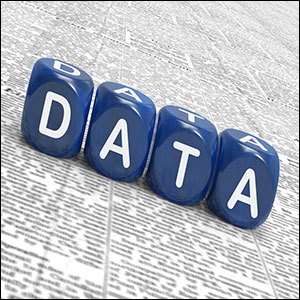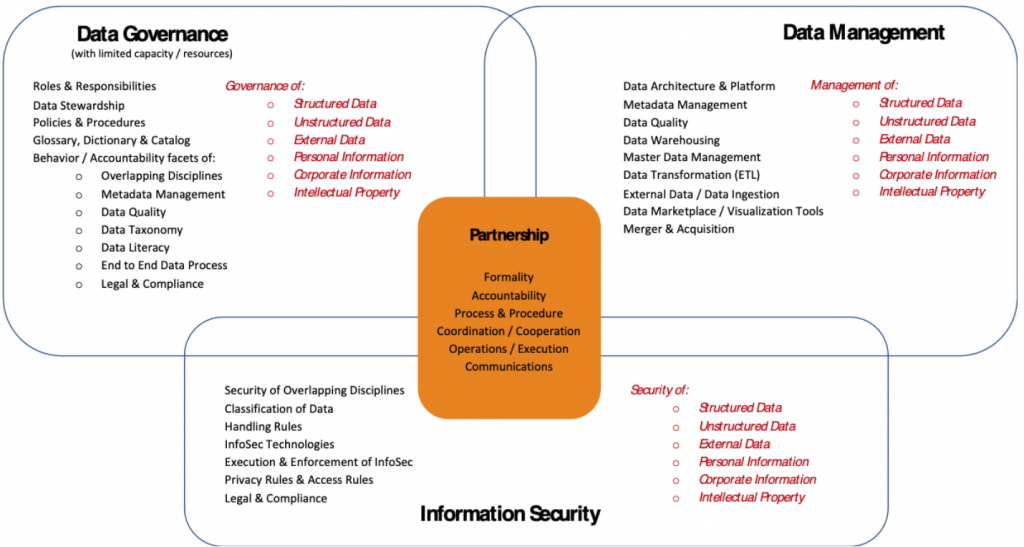
What does your head do when someone uses the expression “same difference”? Mine explodes! Does it mean things are the same? Does it mean there is a difference? Please don’t use that expression. It is very confusing. It is all in the data.
Word on the street (my clients included) is that there is significant confusion about the similarities and differences between Data Governance and Data Management and the functions of the same name within organizations.
There is no standard or single correct way to organize or address the two disciplines. Organizations need both disciplines– even if that means they are directed by and/or carried out by the same, or different, people.
Let’s start with familiar and simple definitions of Data Governance and Data Management.
Data Governance is all about people, their accountability, and their behavior with data. My definition of Data Governance is “the execution and enforcement of authority over the definition, production, and use of data.” Some may say that the “definition, production, and use of data” is the management of data. Let’s not get ahead of ourselves. I hesitate to use the expression “management of data” when describing the “governance of data”.
Data Governance focuses on what I refer to as the Bill of “Rights” (notice the quotes). Data Governance is all about getting the “right” people with the “right” knowledge working with the “right” data in the “right” way at the “right” time resulting in the “right” decision.
It takes effort to achieve all of these “rights”. There is effort associated with getting each of the core components of my Data Governance Framework “right” for your organization. The components include data, roles, processes, communications, metrics, and tools. The work involves metadata management and the administration of the data catalog. This work includes policy, guidelines, standards, the ownership, and the stewardship of the data. If you notice… all of these work efforts are geared toward getting people to behave in a more formal and appropriate manner leading to consistency and improved value from data.
As I wrote earlier, Data Governance is all about the people. These people are often referred to as Data Stewards– or people who define, produce, and use data as part of their job, and that are held formally accountable for their relationship to the data. I once wrote (and state often), that Everybody is a Data Steward if they are held formally accountable for their relationships to the data. Years ago, I also wrote about the Stewardship Approach to Data Governance (an old TDAN.com series that preceded and laid the foundation for my Non-Invasive Data Governance book). Data Governance has always been the execution and enforcement of authority, with Data Stewardship being the formalization of accountability… basically all about the people.
In a typical organization, Data Governance may include:
- Governing and Operational Roles & Responsibilities
- Data Stewardship – Formal Accountability for Data
- Data Policies & Governing Procedures
- Data Documentation – Glossary, Dictionary, Catalog
- Behavioral Facets of:
- Metadata
- Data Quality
- Data Taxonomy
- Data Literacy
- Data Processes
- Legal & Compliance
But you may ask, “Don’t all of the items I mentioned (metadata, data catalog, policy, guidelines, etc.) fall under Data Management too?” The answer to that question lies in your definition of Data Management.
According to Dataversity, Data Management can be defined as a comprehensive collection of practices, concepts, and processes dedicated to leveraging data assets for business success and compliance with data regulations. It spans the entire lifecycle of a given data asset from its original creation point to its final retirement, from end to end of an enterprise.
According to IBM, Data Management is the practice of ingesting, processing, securing, and storing an organization’s data, where it is then utilized for strategic decision-making to improve business outcomes.
Both of these definitions state that Data Management focuses on the delivery of practices and processes targeted at successful business outcomes. Data Management is often broken down into sub-disciplines that vary in number depending on the framework that is being used. [i.e., The DAMA framework– the DAMA Wheel– has 10-11 knowledge areas (depending on the version). The CMMI Data Management Maturity framework has 5 core areas. The EDM Council DCAM framework has 8 areas.] Typical areas that overlap from these frameworks include Data Architecture, Data Quality, Metadata Management, Data Operations, and of course, Data Governance (as the behavioral aspect of Data Management).
In a typical organization, Data Management may include the delivery of:
- Data Modeling and Data Architecture Platforms
- Data Warehousing, Business Intelligence and Analytical Platforms
- Metadata Management Platforms
- Data Quality Assurance
- Master Data Management
- Data Transformation – Digital and Business
- External Data and Data Ingestion
- Data Marketplace, Reporting and Visualization
The fact that Data Governance is called out specifically within each of the popular Data Management frameworks demonstrates that DAMA International, the CMM Institute, and the EDM Council find it necessary to separate the disciplines of Data Management and Data Governance. It may be fair to say that Data Governance is a subject area of a Data Management framework and strategy, at least according to these frameworks. But think twice before you say that they are the same thing.
I recently assisted a client to describe the differences and the similarities (the same difference) between Data Governance and Data Management for their respective team leaders. The client asked that Information Security was also included in the description. The resulting diagram (above) demonstrates that the overlap in these disciplines focus on partnership in terms of formality, accountability, process, coordination, and communication. Data Governance focuses on the people. Data Management focuses on the delivery of information technology-based outcomes. Information Security focused on the protection of sensitive information.
All three disciplines, with their overlapping partnership, are set up to incrementally focus on several types of data throughout the organization including:
- Structured Data – Typical Data Governance
- Unstructured Data – Records Management, Content Management, …
- External Data – Acquired Data
- Personal Information – Classified and Handled
- Corporate – Operational Data
- Intellectual Property – Company Protected Data
However, all three disciplines overlap in the fact that they are required to work in harmony with each other. If your organization is presently confused about “who does what” when it comes to how the disciplines of Data Governance and Data Management overlap, perhaps, separating them into 1) the people and behavioral activities and 2) the delivery of successful business outcomes through architecture, platforms, and data solutions is a simple way to view the same differences between the two.
As a matter of language– the phrase “same difference” is an idiom (phrase used in casual conversation) used to express a speaker’s belief that two or more things are essentially the same, in spite of apparent differences. Because of their close connection, maybe the statement should be “Data Governance, Data Management, same difference.” Or maybe not. It’s all in the data.

